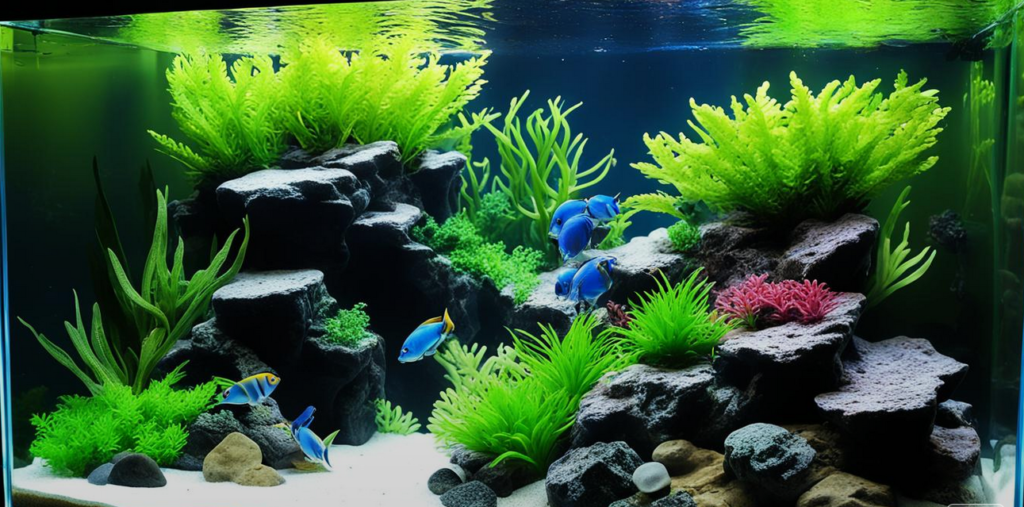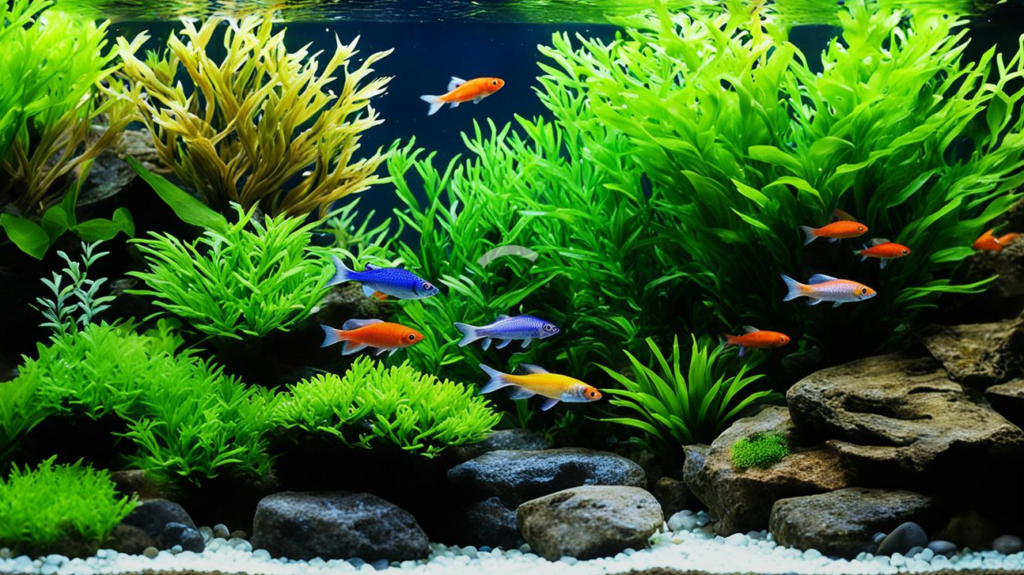To keep a freshwater aquarium healthy and thriving, you need to pay attention to several key points.

A school of colorful freshwater fish swimming in a lush green aquatic plant environment, with bubbles rising up from their mouths as they move gracefully in the water. This guide will help you with water care, setting up the right tank, picking the best equipment, and looking after your fish. Doing things the right way will make a good home for your fish.
Here are the essential parts of caring for freshwater fish: conditioning the water, keeping the pH right, and dealing with things like ammonia and nitrates. You also need to pick a tank that’s the right size, set up a good filter, and control the water’s temperature and light. Doing these steps properly means your fish will live in a happy, healthy place.
Key Takeaways
- Perform regular water changes of 15-25% every 1-2 weeks to maintain water quality
- Implement a daily, weekly, and monthly tank maintenance routine
- Maintain optimal pH levels between 6.8 and 7.8 for freshwater aquariums
- Ensure nitrite levels below 0.75 ppm and nitrate levels below 40 ppm
- Use reverse osmosis water and appropriate testing kits for effective aquarium maintenance
Essential Water Maintenance
To keep your freshwater aquarium healthy, start with the right water care. Change aquarium water every one to two weeks, replacing 15 to 25% of it each time. Tanks with lots of fish need more water changes than ones with just a few.
Daily, check the equipment, watch the fish for sickness, and remove extra food. Top the tank off with treated water and keep an eye on the temperature. Monthly tasks include testing water for pH, ammonia, and other levels.
Proper Water Conditioning
Getting the pH balance right is key for fish health. Most freshwater fish like a pH between 6.6 and 6.8 in their tanks. You can fix low pH by using certain types of gravel or by adjusting the water you add. To fix high pH, try driftwood or adding certain types of water.
Regulating pH Levels
It’s crucial to keep ammonia, nitrite, and nitrate levels low. For ammonia, clean the tank, use more aeration, and check the pH. To lower nitrites and nitrates, keep the tank clean, use aeration, and add plants. For low phosphate, clean the tank well and watch how much you feed. To adjust water hardness, use peat or special water types and keep testing.
Controlling Ammonia, Nitrites, and Nitrates
Test your water often to keep it clean. Make 10 to 15% water changes every two weeks. Keep nitrites nearly zero and nitrates under 10 ppm. Check pH, hardness, nitrites, and nitrates every two weeks, plus clean the gravel and change some water.
Aquarium Setup and Equipment
Setting up a successful freshwater aquarium needs the right tank size, good filtration, and proper heating and lighting. These elements help create a healthy, thriving place for your fish.
Choosing the Right Tank Size
Larger aquariums are usually better. They are easier to keep clean because waste gets diluted. Aim for 1 gallon of water for each inch of fish. This way, your fish have enough room to swim and the water stays clean.
Filtration Systems
The right aquarium filtration system is key for good water quality. It helps keep your fish healthy by removing debris, waste, and toxins. A top-quality filtration system is a good investment for your aquarium’s success.
Heating and Lighting Requirements
Keeping the water at the right temperature is crucial. Freshwater fish do best in water that’s between 75-80°F. Good aquarium lighting helps live plants grow and makes your tank look great. LED lights are a smart choice because they’re durable and use less energy than traditional bulbs.

Freshwater Fish Care: Tips for Healthy Aquariums
Fish Acclimation Process
When you add new fish to your aquarium, how you introduce them is key. Float the bag with the fish for 15-20 minutes. Add a bit of your tank’s water every 5 minutes. This slow mix helps the new fish adjust without getting too stressed.
Maintaining Ideal Water Temperature
Keeping the right water temperature is essential for your fish’s health. Most freshwater fish do best in water that’s 72°F – 82°F. Avoid sudden temperature changes which can harm them. Keep a close eye on your aquarium’s heater to prevent this.
Regular Water Changes
Changing some of your aquarium’s water often is crucial. Aim to change about 25 percent every month. This keeps the water clean and helps with nitrate levels. Sticking to this routine is vital for your fish and the water they live in.
Tank Cleaning and Maintenance Schedule
Having a set cleaning plan ensures your freshwater tank stays healthy. Test the water, remove debris, and clean the decorations regularly. Don’t overfeed, as it causes more waste and can make algae grow. A balanced and tidy tank means happier, healthier fish who are less likely to get sick.
Maintaining Fish Health
Keep a close watch on your fish. Look for any unusual behavior or changes in how they look. Signs of possible sickness include not swimming right, looking different, having wounds, or a big belly. If you notice any of these, it’s wise to act fast. Diseases like parasites, fungus, and bacteria can quickly affect others in the tank.
Preventing Common Fish Diseases
Good water quality is key to a healthy tank. Aim for the right levels of ammonia, nitrite, and nitrate, and the best pH and temperature. Regularly changing some of the water, keeping the filter working well, and not feeding too much are critical steps too.
Quarantining New or Sick Fish
Put any new fish or sick fish in a different tank first. This step is great for stopping the disease from getting to your other fish. It lets you treat the fish as needed and make sure they’re healthy before they join the rest. Always carefully adjust the water when moving new fish into the main tank.

| Aquarium Parameter | Freshwater | Saltwater |
|---|---|---|
| pH | 6.6 – 6.8 | 7.6 – 8.4 |
| Temperature | 72°F – 82°F | 75°F – 80°F |
| Water Changes | 25% monthly | 25% monthly |
Stay diligent in looking after your fish and their home. Good water and preventing issues go a long way in keeping your aquarium fish health party going. Always quarantine to keep diseases in check.
Conclusion
Keeping a clean, healthy freshwater aquarium needs careful attention. You must watch the water quality, set up the right equipment, and care for your fish actively. Do these things right, and your fish will live happily in a beautiful, stress-free place.
Changing 10-25% of the water every 1-2 weeks is key to a healthy aquarium. The amount and how often you change the water depends on the tank size, how many fish are in there, how well the filter works, and how well you take care of it.
With the proper care and knowledge, owning a freshwater tank is very rewarding. It not only makes your living space more beautiful but also makes your pet fish happy. Taking care of the water, equipment, and fish health means a happy and thriving fish tank.
Companies like FantaSEA Aquariums offer maintenance programs to keep your tank in top shape. By doing what they recommend, your aquarium will be a lovely and peaceful place for your fish to grow and be healthy.
FAQ
What is the importance of water maintenance in a freshwater aquarium?
Keeping the water in your aquarium clean and safe is crucial. Without it, your fish could get stressed, sick, or even die.
It’s vital to check the water daily and do bigger tasks weekly and monthly. This helps avoid problems with the water’s quality.
How do I choose the right tank size for my freshwater aquarium?
Bigger tanks are better because they can dilute waste and other harmful substances. A good rule to follow is having 1 gallon for every inch of fish you plan to have.
Choosing the right filter is also key. You might need one that cleans mechanically, biologically, and chemically.
What is the acclimation process for introducing new fish to my aquarium?
When you’re adding new fish, how you introduce them is vital. Start by letting their bag float in the tank for 15-20 minutes.
Then, slowly add some of your tank’s water to the bag every 5 minutes. This helps the fish get used to the new water’s temperature and conditions.
How can I identify and treat common fish health issues?
Watch your fish closely for any odd behavior or signs of sickness. Look for things like acting differently, changing colors, having wounds, or getting very bloated.
If you see these signs, your fish might have parasites, fungus, or a bacterial infection. It’s crucial to catch and treat these issues early. Isolating new or sick fish can also stop the sickness from spreading to the others.
What are the key factors for maintaining a thriving freshwater aquarium?
To keep your aquarium flourishing, focus on several important things. First, always check the water’s quality.
Then, make sure your equipment is right and you take good care of your fish. This means conditioning the water, keeping the right pH, and controlling waste. Choose a suitable tank and use a good filter. Also, keep the water and light at the right levels.





One Comment